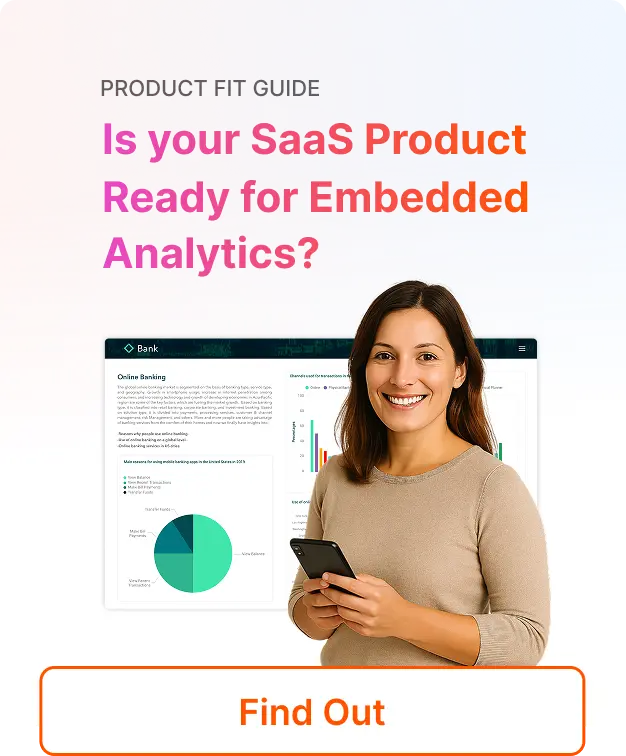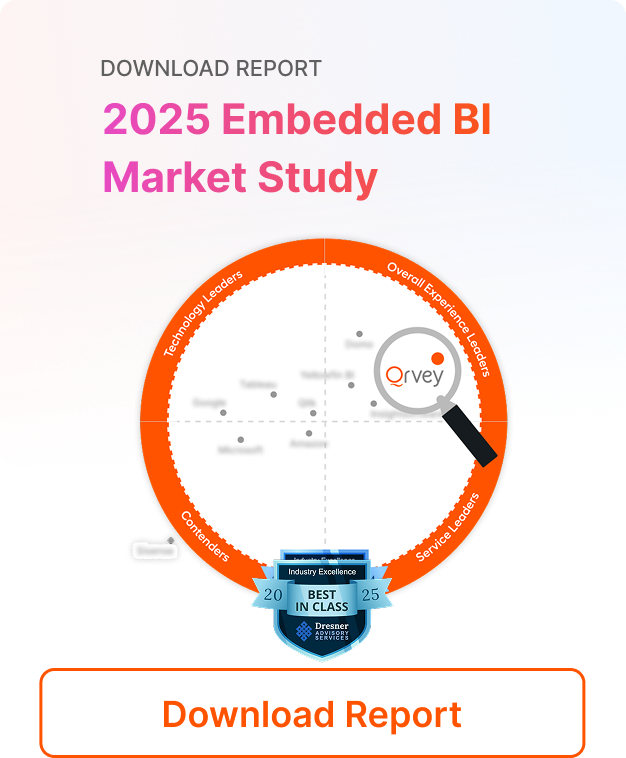
⚡Key Takeaways
- Agentic architecture is a modular design pattern for autonomous AI systems that perceive, plan, act, and learn in continuous loops—prioritizing goals, tools, and feedback over one-shot prompts.
- Its core components are perception, memory/knowledge, cognition, planning, tool use, action, feedback, and learning—coordinated by orchestration and governance layers.
- In practice, agentic AI follows a closed loop: ingest goal → gather context → decompose tasks → choose tools → execute → critique → adapt.
- For product teams, agentic architecture enables agentic analytics in apps: from auto-generated dashboards to proactive insights—well served by platforms like Qrvey.
The fastest-moving AI products today don’t just answer questions—they pursue goals. That’s the promise of agentic architecture: systems that continuously perceive context, plan multi-step strategies, take actions via tools, and learn from feedback. In short, agentic AI turns large models into problem-solving agents you can trust to operate with guardrails and measurable outcomes.
In the guide below, you’ll see how agentic architecture works, the components and types you can choose from, and where it fits best in SaaS. We’ll close by showing how to bring agentic analytics to life with Qrvey’s embedded analytics platform inside your product.
Understanding agentic architecture
Agentic architecture is a blueprint for AI systems that behave like autonomous analytics: they interpret the world (perception), decide (cognition + planning), use tools (action), and improve over time (feedback + learning). Unlike traditional, linear AI pipelines, agentic systems are goal-directed and adaptive, operating in tight perception–plan–act–learn loops with human-in-the-loop checkpoints when needed.
Pro tip: Think of agentic AI as a “full stack” around an LLM: the model is the brain, but the architecture provides memory, tools, feedback, and governance.
Core components of agentic architecture
The following modular layers can be mixed and matched depending on your use case and risk profile.
1) Perception (environment & data intake)
Collects and normalizes signals—text, events, API responses, docs, logs, metrics—into a structured state. It often includes schema mapping, entity extraction, and policy-aware filtering (e.g., PII handling) before facts enter memory.
2) Memory & Knowledge (short-/long-term)
Holds conversation state, retrieved documents, embeddings (RAG), and summarized trajectories. Good memory reduces rework, improves reasoning, and keeps agents aligned with business context and user preferences.
3) Cognition & Reasoning
The “thinking” core: chain-of-thought, tool-augmented reasoning, self-consistency, and critique. Includes objective functions that balance accuracy, cost, latency, and risk. May use multiple models (e.g., planner vs. solver).
4) Planning & Task Decomposition
Breaks goals into sub-tasks, sets success criteria, and determines dependencies. For analytics use cases, planning can encode decision logic (filters, metrics, segments) and tailor outputs to user roles and preferences. With Qrvey, the planning layer can automate decision logic and adapt to user behavior by leveraging in-product interactions and metadata.
5) Tooling & Integration Layer
Connectors and function calls for CRUD operations, search, ETL/ELT, BI queries, workflow engines, ticketing, or external APIs. The agent selects tools, validates parameters, and executes with least privilege.
6) Action/Execution Engine
Runs tasks, handles retries, compensating actions, and transactionality. In analytics products, this may render dashboards, trigger alerts, or write back to operational systems.
7) Feedback, Evaluation & Critique
Captures outcomes, human annotations, tests, and telemetry (latency, cost, correctness). Implements red teaming, content filters, and business rules. Critical for safety, SLAs, and continuous improvement.
8) Learning & Adaptation
Updates memories, preferences, and policies. May retrain embeddings, tune prompts, or adjust routing thresholds. In production, most learning is policy- and data-driven rather than model-weight training.
9) Orchestration & Governance
Coordinates agents, manages state, enforces guardrails, RBAC, lineage, audits, and approvals. Provides observability to track prompts, tool calls, and outcomes. For agentic analytics, Qrvey centralizes ingestion → transformation → visualization → AI in one stack to simplify governance.
How agentic architecture operates in practice
At runtime, the agent follows a repeatable, auditable loop:
Step 1: Goal intake & scoping
Receive the user’s objective (e.g., “Find churn risk drivers and draft an outreach plan”). Clarify constraints, required outputs, and success metrics. Establish whether human approval is needed before acting.
Step 2: Context gathering (perception + retrieval)
Collect relevant data: product logs, CRM records, tables, docs, and prior conversations. Apply retrieval-augmented generation and policy filters so the agent reasons over authorized context.
Step 3: Plan & decompose
Generate a step-by-step plan with sub-tasks, tool selections, and validation checks. Define acceptance criteria for each output (e.g., “explainable top-5 drivers with SHAP-like summaries”).
Step 4: Tool selection & parameterization
Pick the right connectors (SQL, BI query, vector search, ETL, email API). Validate parameters, enforce schema and permissions, and simulate side effects before execution.
Step 5: Execute actions
Run analytics queries, produce charts, generate summaries, and propose next actions in the app UI. In embedded AI products, agents can publish dashboards or alerts via Qrvey’s platform.
Step 6: Critique & evaluate
Check outputs against tests (factuality, policy, cost). If results fail thresholds, revise the plan or prompt and re-run targeted steps rather than the entire workflow.
Step 7: Learn & update state
Store results, user feedback, and success/failure annotations. Update retrieval indices and preferences so future plans start smarter.
Types of agentic architectures
1) Single-agent, reflexive (planner–executor in one)
A single agent plans, acts, and critiques itself—ideal for scoped tasks.
Pros
- Simplicity: Fewer moving parts, faster to ship.
- Lower cost: Minimal inter-agent chatter and orchestration overhead.
Cons
- Limited specialization: One agent may underperform on niche tasks.
- Scalability constraints: Harder to parallelize complex workflows.
Best for / use cases
- Tactical analytics: Crafting one-off insights, summarizing dashboards, or writing executive briefs from BI data inside your app with agentic analytics.
2) Hierarchical planner–worker
A “manager” agent decomposes work to specialized executors (SQL writer, visualizer, summarizer).
Pros
- Division of labor: Better results on multi-skill tasks.
- Control: The manager enforces standards and checkpoints.
Cons
- Overhead: More orchestration, state passing, and failure modes.
- Latency: Inter-agent coordination increases round-trips.
Best for / use cases
- Decision support at scale: Automated analyses that output charts + narrative + recommended actions in embedded BI.
3) Multi-agent collaborative (peer network)
Specialized agents collaborate (e.g., data engineer, analyst, product PM), with consensus or debate mechanisms.
Pros
- Robustness: Diverse perspectives reduce single-model biases.
- Parallelism: Agents can work concurrently on sub-tasks.
Cons
- Complexity: Harder to debug and audit.
- Cost management: Many messages = higher spend without careful routing.
Best for / use cases
- Exploratory analytics & what-ifs: When the problem benefits from competing hypotheses and cross-checks.
4) Tool-augmented, action-centric
Agents tightly integrated with enterprise tools: SQL, warehouses, ETL, CRMs, ticketing, messaging.
Pros
- Business impact: Agents do things, not just talk about them.
- Traceability: Tool calls produce logs and lineage for audits.
Cons
- Security posture: Needs strong RBAC, secrets, and sandboxing.
- Change risk: Guardrails are mandatory to avoid bad writes.
Best for / use cases
- Operational analytics & activation: Trigger lifecycle campaigns, create tickets, update forecasts—surfacing inside your product via Qrvey’s embedded workflows.
5) Workflow-centric (agentic RPA)
A deterministic workflow engine with agentic substeps for unstructured reasoning.
Pros
- Predictability: SLAs and compliance are easier to meet.
- Composability: Reuse workflows across teams and customers.
Cons
- Less autonomy: Creative leaps are constrained by the workflow.
- Maintenance: Versioning and change control required.
Best for / use cases
- Regulated or high-stakes tasks: Financial reporting, health checks, or audit-ready processes where you embed AI into an existing workflow using Qrvey.
6) Edge/embedded agents
Lightweight agents running close to data sources (devices, private networks).
Pros
- Latency & privacy: Data stays local, responses are snappy.
- Reliability: Operates even with intermittent connectivity.
Cons
- Resource limits: Smaller models, limited memory/tooling.
- Ops overhead: Fleet management and updates.
Best for / use cases
- IoT analytics & on-prem scenarios where data egress is limited but insights must appear in-app, with centralized rollups in your SaaS via Qrvey.
Technologies powering agentic architectures
- Foundation models & reasoners: LLMs for language, code, and planning; small task models for classification or routing.
- Retrieval & memory stores: Vector databases for embeddings, document stores for facts, temporal stores for user/session history.
- Tooling & function calling: Schema-validated functions (SQL, HTTP, BI queries), tool registries, and parameter guards.
- Orchestrators & state machines: To manage agents, retries, and compensating actions; event buses/queues to decouple steps.
- Observability & policy engines: Telemetry, lineage, prompt/tool logs, security policies, and red-team filters.
- Interoperability (the key to scale): Agentic systems win when components snap together. In analytics, Qrvey connects data ingestion, transformation, visualization, and AI in one stack—so agents can retrieve governed data, generate dashboards, and trigger actions within your product.
Challenges in deploying agentic architecture
1) Safety, security & governance
Agents that can act must be prevented from harmful or non-compliant operations. Enforce RBAC, least privilege, data masking, and approval gates. Centralize secrets and use policy checks before actions. Embedded stacks like Qrvey help by keeping analytics, data access, and actions inside a governed environment.
2) Explainability & auditability
Stakeholders need to know why an agent chose a path. Log prompts, tool parameters, data sources, and outputs; store reasoning summaries. Provide “open the hood” drill-downs in dashboards so users can inspect lineage.
3) Data quality & drift
Garbage in = garbage out. Maintain observability on data freshness, schema changes, and semantic drift. Agents should detect anomalies and request confirmation before using suspect data.
4) Reliability, cost & performance
Reasoning depth, tool chatter, and retrieval sizes affect latency and spend. Use routing (choose the smallest capable model), cache frequent retrievals, and set budget guards per user/session.
5) Human-in-the-loop operations
Define when humans approve plans, iterate prompts, or accept outputs. Build UX for review and feedback so learning improves over time. In embedded analytics, surface these controls directly in-app via Qrvey.
6) Change management & adoption
Agentic AI changes how teams work. Train users on capabilities and limits, set clear SLAs, and start with narrow, high-value use cases before expanding.
Tip: Pair each challenge with a concrete control (metric, guardrail, checklist). Treat agents like services with SLOs.
Bringing agentic architecture to life with Qrvey for Agentic Analytics
If your goal is to deliver artificial intelligence in your SaaS product—not just answer questions in a chat—Qrvey provides the connective tissue: governed ingestion, transformations, a rich visualization layer, and AI features that let agents retrieve the right data, generate dashboards and narratives, and trigger actions without leaving your app.
- Speed to value: Ship agent-assisted insights and proactive alerts faster using Qrvey’s embedded analytics platform.
- Governance by design: Keep data access, lineage, and actions in one auditable plane.
- User-aware experiences: Let agents adapt outputs to roles and preferences, informed by in-app behavior.
Next step: Book a demo to explore how Qrvey incorporates advanced AI into embedded analytics and see how AI enhances embedded BI in SaaS.

Arman Eshraghi is the CEO and founder of Qrvey, the leading embedded analytics solution for SaaS companies. With over 25 years of experience in data analytics and software development, Arman has a deep passion for empowering businesses to unlock the full potential of their data.
His extensive expertise in data architecture, machine learning, and cloud computing has been instrumental in shaping Qrvey’s innovative approach to embedded analytics. As the driving force behind Qrvey, Arman is committed to revolutionizing the way SaaS companies deliver data-driven experiences to their customers. With a keen understanding of the unique challenges faced by SaaS businesses, he has led the development of a platform that seamlessly integrates advanced analytics capabilities into software applications, enabling companies to provide valuable insights and drive growth.
Popular Posts
Why is Multi-Tenant Analytics So Hard?
BLOG
Creating performant, secure, and scalable multi-tenant analytics requires overcoming steep engineering challenges that stretch the limits of...
How We Define Embedded Analytics
BLOG
Embedded analytics comes in many forms, but at Qrvey we focus exclusively on embedded analytics for SaaS applications. Discover the differences here...
White Labeling Your Analytics for Success
BLOG
When using third party analytics software you want it to blend in seamlessly to your application. Learn more on how and why this is important for user experience.








